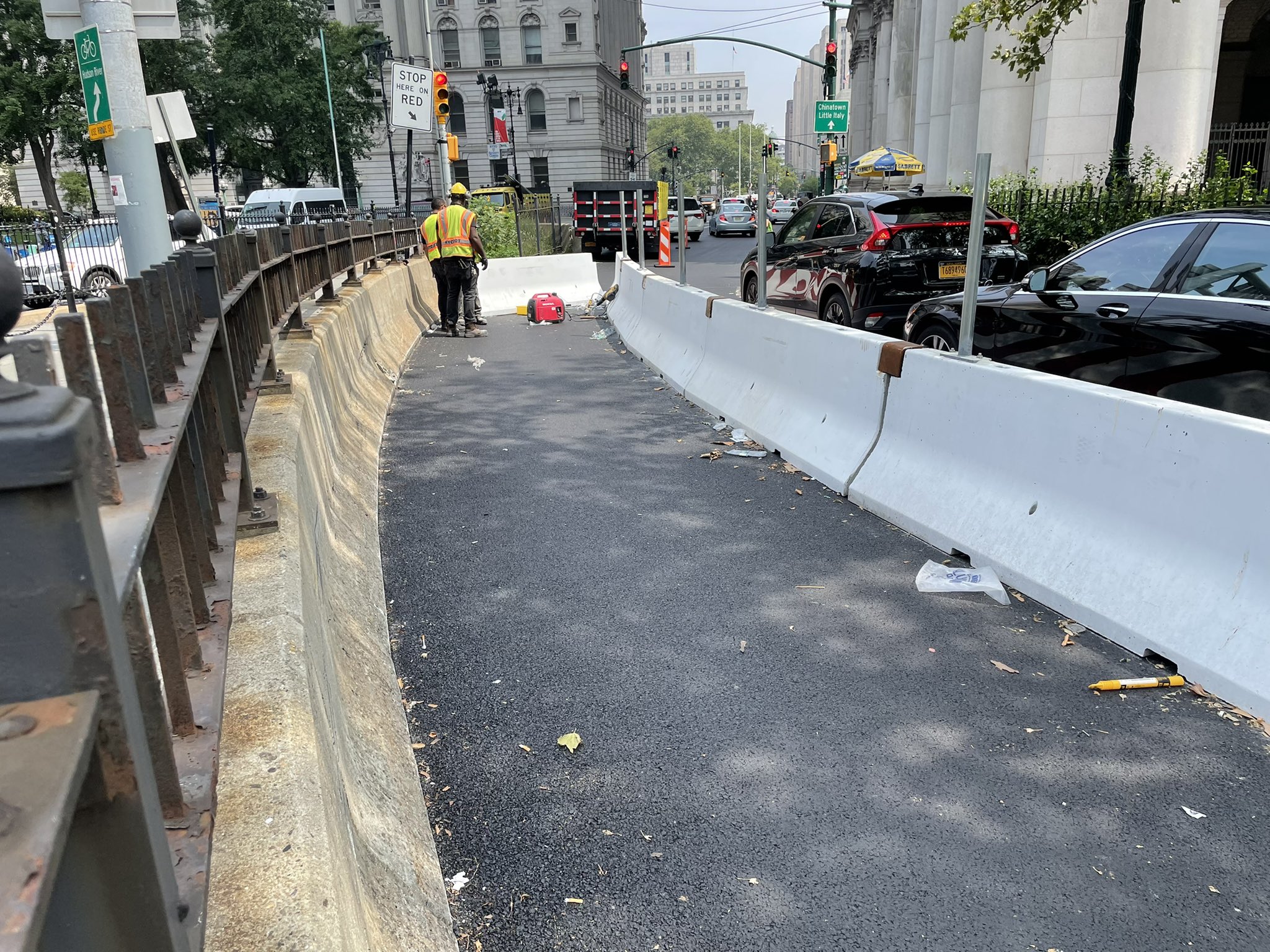It's a tight fit, but at least it exists.
The Brooklyn Bridge bike lane, last seen on this website taking shape in the beautiful hills of Brooklyn, can now be seen up close and in person in Manhattan, but it will be a few months before cyclists can take advantage of it.
Construction on the bike lane, which runs on the bridge's Manhattan-bound roadbed, began in June, six months after plans were announced by Mayor de Blasio in his State of the City address. The two-way lane, blessedly, will solve the problem of the cramped shared promenade that cyclists and pedestrians have to contend with now. Those conditions led to fewer cyclists crossing the Brooklyn Bridge during the coronavirus bike boom, even as as more people rode over the city's other East River bridges.
It has the makings of a legacy project for de Blasio, but the eight-foot wide path doesn't leave much room for error, and is in some sense the least the mayor can do. According to the National Association of City Transportation Officials, eight feet is the minimum recommended width for a two-way bike lane, while 12-feet wide is the more preferred size.
The narrow path and sudden turnaround on longstanding DOT opposition to building the roadbed bike lane has also led to a delightful conspiracy theory that the Manhattan-bound bike lane was always meant to be a one-way bike lane with a matching lane on the Brooklyn-bound side.
What gave it away? Couldn't be the fact that the first rendering had an arrow in only one direction, eh? pic.twitter.com/9HQar6Icnm
— Second Ave. Sagas (@2AvSagas) July 26, 2021
DOT officials have said that they are open to making more room for bikes on the Brooklyn Bridge, but that the city can't spare a lane on Brooklyn-bound roadbed because the left lane is needed for bridge maintenance and the right-most lane connects directly to a highway.
"This does not preclude us from having a different solution that would require some sort of capital buildout of additional ramps, more substantial changes to the design of the bridge, anything like that on a longer term," Patrick Kennedy, a representative of the DOT's bike unit told Brooklyn Community Board 2 in April. "This is the lane we can create in 2021 to have operational in 2021."
The DOT still has to add fencing to all of the Jersey barriers, and complete a promised center-running protected bike lane on Centre Street that will allow cyclists to access the bike lane without riding headlong into oncoming traffic. The city also plans on adding a left-turn traffic-signal phase at the intersection of Centre Street and Chambers Street in order to allow cyclists traveling north and south on Centre to make safely it through the intersection— all of which means that the city is still sticking with a "fall" implementation.
"While we are excited that our crews have made such considerable progress over the last month, we have much work left to complete before the new Brooklyn Bridge protected route will be ready for cyclists — including new signal installation and curb reconstruction on either side of the bridge along with a mile of new street markings and green paint," said DOT spokesperson Brian Zumhagen. "We ask New Yorkers for their continued patience."
When the bike lane opens in the fall, it will be the end of a years-long struggle to figure out what to do about the Brooklyn Bridge promenade, whose photo-posing and love lock-locking crowds made it an impossible route to get where you were going. As far back as 2016 the Department of Transportation looked at the feasibility of widening the promenade to add a bike-only path, but the city said that it had to complete a study on whether the bridge's cables were sturdy enough to handle the extra weight from the expanded promenade. The cable study hadn't been finished as of January 2020, but the DOT long resisted the idea of adding a bike lane to the roadbed of the bridge under the theory that it would cause massive traffic backups. The agency suddenly changed course in June 2020 and suggested the roadbed lane was being studied, before de Blasio made his announcement in January.
Once the roadbed bike lane is open, only pedestrians will be allowed to use the Brooklyn Bridge promenade. Enjoy your engagement photos.






